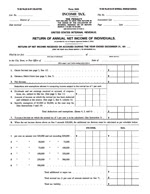 April 17th is U.S. Income Tax Day in 2018 and what better way could there be to mark the occasion that all Americans dread almost more than any other than to provide another income tax form to fill out?
April 17th is U.S. Income Tax Day in 2018 and what better way could there be to mark the occasion that all Americans dread almost more than any other than to provide another income tax form to fill out?
But don't worry - it won't mean having to pay any more income taxes this year. Instead, our tool below will figure out how much you would have had to pay if you were filing to pay your income taxes for 1913. The year for which the Internal Revenue Service first issued its Form 1040.
We modeled our tool after the first page of the original Form 1040, which back then, consisted of just four pages: the summary sheet modeled below (Page 1), the Gross Income calculation sheet (Page 2), the General Deductions sheet (Page 3) and finally, one page of Instructions (Page 4). Yes, you read that right. Just one page of instructions!
We'll make it just a bit easier still. All you need to do is to enter the indicated data below (shown in boldface type, in the rows with a white background) below with your figures from this year, and we'll take care of the math, where we'll show those results in the rows with a gray background, where you won't have to worry about entering any values. If you are accessing this article on a site that republishes our RSS news feed, please click here to access a working version of the tool on our site.
Excerpts from the Instructions
3. The normal tax of 1 per cent shall be assessed on the total net income less the specific exemption of $3,000 or $4,000 as the case may be. (For the year 1913, the specific exemption allowable is $2,500, or $3,333.33, as the case may be.) If, however, the normal tax has been deducted and withheld on any part of the income at the source, or if any part of the income is received as dividends upon the stock or from the net earnings of any corporation, etc., which is taxable upon its net income, such income shall be deducted from the individual's total net income for the purpose of calculating the amount of income on which the individual is liable for the normal tax of 1 per cent by virtue of this return.
19. An unmarried individual or a married individual not living with wife or husband shall be allowed an exemption of $3,000. When husband and wife live together they shall be allowed jointly a total exemption of only $4,000 on their aggregate income. They may make a joint return, both subscribing thereto, or if they have separate incomes, they may make separate returns; but in no case shall they jointly claim more than $4,000 exemption on their aggregate income.
Since 2018 is a year for tax cuts, you might consider clicking through to our bottom line tool that will estimate how much more of the money you earned in your paycheck that you will be allowed to keep through lower income withholding taxes!
Welcome to the blogosphere's toolchest! Here, unlike other blogs dedicated to analyzing current events, we create easy-to-use, simple tools to do the math related to them so you can get in on the action too! If you would like to learn more about these tools, or if you would like to contribute ideas to develop for this blog, please e-mail us at:
ironman at politicalcalculations
Thanks in advance!
Closing values for previous trading day.
This site is primarily powered by:
CSS Validation
RSS Site Feed
JavaScript
The tools on this site are built using JavaScript. If you would like to learn more, one of the best free resources on the web is available at W3Schools.com.